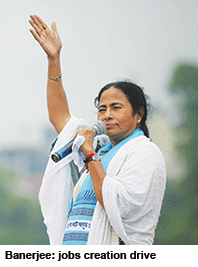West Bengal: Teacher recruitment drive
 Even as West Bengal’s fiery chief minister Mamata Banerjee has emerged as the prime spokesperson of the opposition parties on the issue of demonetisation of the country’s entire stock of Rs.1,000 and Rs.500 currency notes, she is simultaneously shoring up her base in West Bengal by taking initiatives to win over the state’s influential middle class and intelligentsia who are fast losing faith in her Trinamool Congress (TMC) government which was returned to power in the state legislative assembly last May with a landslide majority.
Even as West Bengal’s fiery chief minister Mamata Banerjee has emerged as the prime spokesperson of the opposition parties on the issue of demonetisation of the country’s entire stock of Rs.1,000 and Rs.500 currency notes, she is simultaneously shoring up her base in West Bengal by taking initiatives to win over the state’s influential middle class and intelligentsia who are fast losing faith in her Trinamool Congress (TMC) government which was returned to power in the state legislative assembly last May with a landslide majority.
One of her focus areas in recent months has been to introduce the much-proclaimed poribartan (‘change’) in the state’s languishing education sector. After finalising the recruitment of teachers for the state’s 92,000 government primary-secondary schools last month, the TMC government has shifted its attention to filling faculty vacancies in the state’s 372 colleges and 25 universities, introducing a biometric register to record the attendance of college and university teachers, and improving their remuneration packages.
Meanwhile, interviews of the 2,000 postgraduates who cleared the 19th West Bengal State Eligibility Test (WBSET) to qualify as assistant professors, are being conducted at the time of writing with the 20th WBSET scheduled this month. On November 3, the state education minister Partha Chatterjee informed the media that the government is set to appoint 3,858 assistant professors by the end of 2017.
According to Chatterjee, top-level principals’ vacancies have been filled in 126 government-aided colleges during the past 12 months and a circular to recruit another 170 has been issued. Moreover, the government will soon appoint vice chancellors of Calcutta, Kalyani, West Bengal State, Diamond Harbour Women and Raigunj universities, the Maulana Abdul Kalam Azad Institute of Technology and Sanskrit College and University. All these initiatives translate into jobs for the educated middle class which has been hard hit by the de-industrialisation of West Bengal and flight of capital during 34 years of uninterrupted rule (1977-2011) of the CPM (Communist Party of India-Marxist)-led Left Front government — a phenomenon which the TMC hasn’t been able to reverse as yet.
However Manas Bhuiyan, spokesperson of the opposition Congress party, is unimpressed by this flurry of recruitment activity. “The main objective of the TMC government’s faculty recruitment drive is to infiltrate party members and/or sympathisers into colleges and universities, as the CPM did during its rule. Nor are they likely to find highly-qualified college principals and vice chancellors willing to serve due to continuous commotion on campuses during TMC rule,” says Bhuiyan.
Undoubtedly, breaking the stranglehold of CPM and Left academics who thoroughly infiltrated West Bengal’s — particularly Kolkata’s — academic institutions and continue to dominate them through their powerful students and faculty unions, is an objective of the TMC government. Meanwhile, with the TMC government having failed to attract industrial investment into the state, the education sector offers the only alternative for Banerjee to fulfill her promise to create jobs for middle class youth of West Bengal where the number of registered educated unemployed has crossed the 7.6 million danger mark.
Now bona fide academics are keeping their fingers crossed that the TMC government won’t follow the example of the Left Front government which filled the state’s once highly-respected institutions of education with under-qualified party apparatchiks.
Baishali Mukherjee (Kolkata)
















Add comment